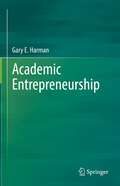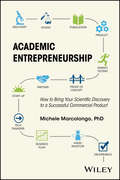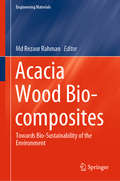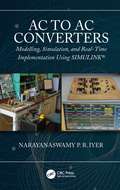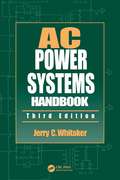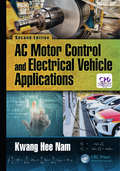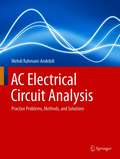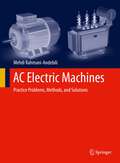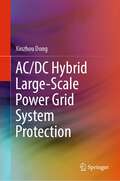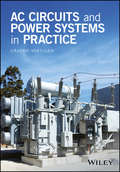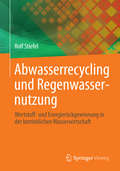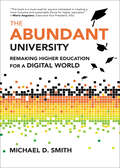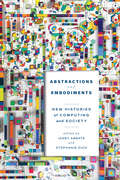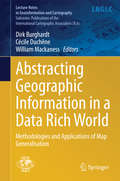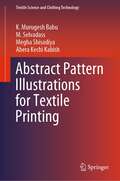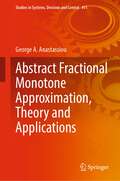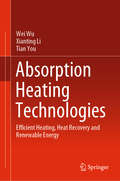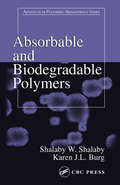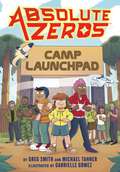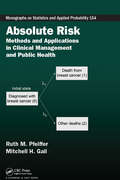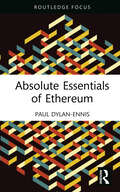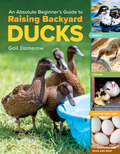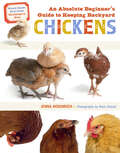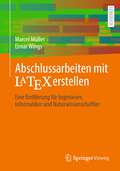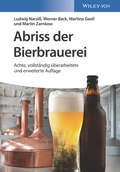- Table View
- List View
Academic Entrepreneurship
by Gary E. HarmanThis book explores different aspects of entrepreneurship from both an academic and a commercial point of view. The first chapter the university culture is considered. The nature of the technology or service is important. Some technologies are adaptive, in that they are developing products that are already in the marketplace, and these fit easily in academic institutions. Other technologies are disruptive and new products must be developed. These fit less easily into university structures since a commercial entity is required. Chapter 4 considers the important requirements of conflict of interest (COI). Either the university culture or COI can hinder or aid entrepreneurial faculty. The second chapter deals with the reasons why an individual faculty might wish to become entrepreneurial. In many cases, a faculty member wants to see their technology in practice and not just a publication in a scientific journal. If a technology is disruptive, then a commercial entity is probably essential. If so, then funding must be obtained. There are “valleys of death” (1) where scientific discoveries to useful products and (2) the development, production and marketing of a commercially viable product. Chapter 6 deals specifically with methods of funding start-up companies. Chapter 3 describes several innovative programs in biology. These include genetic approaches, plant management systems and the author’s own program that deals with microbial approaches to sustainable agriculture. Chapter 5 describes the crucial areas of agreements, contracts, regulatory affairs and patents. These legal documents are critical components of entrepreneurial efforts and must be understood and pursued correctly. Finally, this book could have been entitled “things I wish I had known when I first started commercial activities.” It is my hope that it can make the path of fledgling entrepreneurial smoother and more successful.
Academic Entrepreneurship: How to Bring Your Scientific Discovery to a Successful Commercial Product
by Michele MarcolongoThe pathway to bringing laboratory discoveries to market is poorly understood and generally new to many academics. This book serves as an easy-to-read roadmap for translating technology to a product launch – guiding university faculty and graduate students on launching a start-up company.• Addresses a growing trend of academic faculty commercializing their discoveries, especially those supported by the National Science Foundation and National Institutes of Health• Offers faculty a pathway and easy-to-follow steps towards determining whether their discovery / idea / technology is viable from a business perspective, as well as how to execute the necessary steps to create and launch a start-up company• Has a light-hearted and accessible style of a step-by-step guide to help graduate students, post-docs, and faculty learn how to go about spinning out their research from the lab• Includes interviews by faculty in the disciplines of materials science, pharmaceuticals, medical devices, information technology, energy, and mechanical devices – offering tips and discussing potential pitfalls to be avoided
Acacia Wood Bio-composites: Towards Bio-Sustainability of the Environment (Engineering Materials)
by Md Rezaur RahmanThis book investigates the enhancement of properties of acacia wood and its surface treatment for high strength bio-composites. It describes the tensile, flexural and impact strength, surface behaviour, morphological analysis, infrared spectral functional analysis, thermal properties analysis and dielectrical properties of acacia wood bio-composites. It reports efforts on the optimization of fabrication techniques to prepare acacia wood reinforced bio-composites based on PLA, PHA, Etc. The book also reports on environmental impact analysis of acacia wood bio-composites. A special chapter is dedicated to the nano-enhancement of acacia wood bio-composites and their possible use in applications in terms of sustainability and economics.
AC to AC Converters: Modeling, Simulation, and Real Time Implementation Using SIMULINK
by Narayanaswamy P IyerPower electronic converters can be broadly classified as AC to DC, DC to AC, DC to DC and AC to AC converters. AC to AC converters can be further classified as AC Controllers or AC regulators, Cycloconverters and Matrix converters. AC controllers and cycloconverters are fabricated using Silicon Controlled Rectifiers (SCR) whereas matrix converters are built using semiconductor bidirectional switches. This text book provides a summary of AC to AC Converter modelling excluding AC controllers. The software Simulink® by Mathworks Inc., USA is used to develop the models of AC to AC Converters presented in this text book. The term model in this text book refers to SIMULINK model. This text book is mostly suitable for researchers and practising professional engineers in the industry working in the area of AC to AC converters. Features Provides a summary of AC to AC Converter modelling excluding AC controllers Includes models for three phase AC to three phase AC matrix converters using direct and indirect space vector modulation algorithm Presents new applications such as single and dual programmable AC to DC rectifier with derivations for output voltage Displays Hardware-in-the Loop simulation of a three phase AC to single phase AC matrix converter Provides models for three phase multilevel matrix converters, Z-source Direct and Quasi Z-source Indirect matrix converters; a model for speed control and brake by plugging of three phase induction motor and separately excited DC motors using matrix converter; a model for a new single phase and three phase sine wave direct AC to AC Converter without a DC link using three winding transformers and that for a square wave AC to square wave AC converter using a DC link; models for variable frequency, variable voltage AC to AC power supply; models for Solid State Transformers using Dual Active Bridge topology and a new direct AC to AC Converter topology; and models for cycloconverters and indirect matrix converters
AC Power Systems Handbook (Electronics Handbook Series)
by Jerry C. WhitakerSooner or later, power system protection is going to cost money. How much is entirely up to you. Setting up a safe and effective AC power system from the very beginning can help avoid costly downtime and repairs, provide backup power during system outages, and minimize workplace accidents. For the past 15 years, Jerry Whitaker's AC Power Systems Handbook has supplied industry professionals with a comprehensive, practical guide to the key elements of AC power for commercial and industrial systems.This third edition is thoroughly revised and completely reorganized to reflect the changing demands of modern power systems. To ease navigation, many sections are now presented as separate chapters filled with updated and expanded information. Most notably, the author adds heavily in the areas of transient suppression hardware, electrical system components, and power system fundamentals. Following a logical progression, coverage flows from power system operation to protecting equipment loads, selecting the right level of protection, grounding, standby power, and safety. Along the way, the author paints a clear picture of the sources of disturbances, the tradeoffs involved for different options, and the advantages and limitations of various approaches.Streamlined to be a hands-on, user-oriented guide, the AC Power Systems Handbook offers expert guidance on designing and installing a safe and efficient power system.
AC Motor Control and Electrical Vehicle Applications
by Kwang Hee NamAC Motor Control and Electrical Vehicle Applications provides a guide to the control of AC motors with a focus on its application to electric vehicles (EV). It describes the rotating magnetic flux, based on which dynamic equations are derived. The text not only deals with the induction motor, but covers the permanent magnet synchronous motors (PMSM). Additionally, the control issues are discussed by taking into account the limitations of voltage and current. The latest edition includes more experimental data and expands upon the topics of inverter, pulse width modulation methods, loss minimizing control, and vehicle dynamics. Various EV motor design issues are also reviewed, while comparing typical types of PMSMs. Features Considers complete dynamic modeling of induction and PMSM in the rotating frame. Provides various field-oriented controls, while covering advanced topics in PMSM high speed control, loss minimizing control, and sensorless control. Covers inverter, sensors, vehicle dynamics, driving cycles, etc., not just motor control itself. Offers a comparison between BLDC, surface PMSM, and interior PMSM. Discusses how the motor produces torque and is controlled based on consistent mathematical treatments.
AC Electrical Circuit Analysis: Practice Problems, Methods, and Solutions
by Mehdi Rahmani-AndebiliThis study guide is designed for students taking courses in electrical circuit analysis. The textbook includes examples, questions, and exercises that will help electrical engineering students to review and sharpen their knowledge of the subject and enhance their performance in the classroom. Offering detailed solutions, multiple methods for solving problems, and clear explanations of concepts, this hands-on guide will improve student’s problem-solving skills and basic understanding of the topics covered in electric circuit analysis courses.Exercises cover a wide selection of basic and advanced questions and problemsCategorizes and orders the problems based on difficulty level, hence suitable for both knowledgeable and under-prepared studentsProvides detailed and instructor-recommended solutions and methods, along with clear explanationsCan be used along with the core textbooks in AC circuit analysis and advanced electrical circuit analysis
AC Electric Machines: Practice Problems, Methods, and Solutions
by Mehdi Rahmani-AndebiliThis study guide is designed for students taking upper-level undergraduate courses in AC electrical machines. The textbook includes examples, questions, and exercises covering transformers, induction machines, and synchronous machines that will help students review and sharpen their knowledge of the subject and enhance their performance in the classroom. Offering detailed solutions, multiple methods for solving problems, and clear explanations of concepts, this hands-on guide will improve student problem-solving skills and understanding of the topics covered.
AC/DC Hybrid Large-Scale Power Grid System Protection
by Xinzhou DongSystem protection is laid between the defenses for power system protective relaying and the emergency control. Under the premise of ensuring the safety of electrical equipment, it strives to ensure the safety of the system, block the chain of occurrence and growth of cascading faults, and effectively avoid the occurrence of large-scale blackout catastrophes. This book systematically elaborates on the dealing technology of a special type of fault, the “cascading fault”, in the AC-DC hybrid large-scale power grid. The main contents include immunization distance protection for accident overload; distance protection that is immune to oscillation; inverter control technology to prevent long-term or continuous commutation failure; DC participation emergency power flow control technology used to share the accident transfer overload caused by inverter lockout; and overhead transmission line adaptive overload protection.The basis of English translation of this book from its Chinese original manuscript was done with the help of artificial intelligence (machine translation by the service provider DeepL.com). A subsequent human revision of the content was done by the author.
AC Circuits and Power Systems in Practice
by Graeme VertiganThe essential guide that combines power system fundamentals with the practical aspects of equipment design and operation in modern power systems Written by an experienced power engineer, AC Circuits and Power Systems in Practice offers a comprehensive guide that reviews power system fundamentals and network theorems while exploring the practical aspects of equipment design and application. The author covers a wide-range of topics including basic circuit theorems, phasor diagrams, per-unit quantities and symmetrical component theory, as well as active and reactive power and their effects on network stability, voltage support and voltage collapse. Magnetic circuits, reactor and transformer design are analyzed, as is the operation of step voltage regulators. In addition, detailed introductions are provided to earthing systems in LV and MV networks, the adverse effects of harmonics on power equipment and power system protection. Finally, European and American engineering standards are presented where appropriate throughout the text, to familiarize the reader with their use and application. This book is written as a practical power engineering text for engineering students and recent graduates. It contains more than 400 illustrations and is designed to provide the reader with a broad introduction to the subject and to facilitate further study. Many of the examples included come from industry and are not normally covered in undergraduate syllabi. They are provided to assist in bridging the gap between tertiary study and industrial practice, and to assist the professional development of recent graduates. The material presented is easy to follow and includes both mathematical and visual representations using phasor diagrams. Problems included at the end of most chapters are designed to walk the reader through practical applications of the associated theory.
Abwasserrecycling und Regenwassernutzung: Wertstoff- und Energierückgewinnung in der betrieblichen Wasserwirtschaft
by Rolf StiefelDarstellung der sich versch#65533;rfenden Anforderung hinsichtlich Wassergewinnung, h#65533;here Anforderung bei der Abwassereinleitung sowie der Preisdruck bei Energie- und Rohstoffen. L#65533;sungsm#65533;glichkeiten f#65533;r Industriebetriebe durch wassersparende Produktion, Abwasserrecycling, Rohstoffr#65533;ckgewinnung, Regenwassernutzung und energieeinsparung.
The Abundant University: Remaking Higher Education for a Digital World
by Michael D. SmithWhy our current system of higher education is financially and morally unsustainable and how to address the crisis with the creative implementation of digital technologies.For too long, our system of higher education has been defined by scarcity: scarcity in enrollment, scarcity in instruction, and scarcity in credentials. In addition to failing students professionally, this system has exacerbated social injustice and socioeconomic stratification across the globe. In The Abundant University, Michael D. Smith argues that the only way to create a financially and morally sustainable higher education system is by embracing digital technologies for enrolling, instructing, and credentialing students—the same technologies that we have seen create abundance in access to resources in industry after industry.The Abundant University explains how we got our current system, why it&’s such an expensive, inefficient mess, and how a system based on exclusivity cannot foster inclusivity. Smith challenges the resistance to digital technologies that we have already seen among numerous institutions, citing the examples of faculty resistance toward digital learning platforms. While acknowledging the understandable self-preservation instinct of our current system of residential education, Smith makes a case for how technology can engender greater educational opportunity and create changes that will benefit students, employers, and society as a whole.
Abstractions and Embodiments: New Histories of Computing and Society (Studies in Computing and Culture)
by Janet Abbate and Stephanie DickCutting-edge historians explore ideas, communities, and technologies around modern computing to explore how computers mediate social relations.Computers have been framed both as a mirror for the human mind and as an irreducible other that humanness is defined against, depending on different historical definitions of "humanness." They can serve both liberation and control because some people's freedom has historically been predicated on controlling others. Historians of computing return again and again to these contradictions, as they often reveal deeper structures.Using twin frameworks of abstraction and embodiment, a reformulation of the old mind-body dichotomy, this anthology examines how social relations are enacted in and through computing. The authors examining "Abstraction" revisit central concepts in computing, including "algorithm," "program," "clone," and "risk." In doing so, they demonstrate how the meanings of these terms reflect power relations and social identities. The section on "Embodiments" focuses on sensory aspects of using computers as well as the ways in which gender, race, and other identities have shaped the opportunities and embodied experiences of computer workers and users. Offering a rich and diverse set of studies in new areas, the book explores such disparate themes as disability, the influence of the punk movement, working mothers as technical innovators, and gaming behind the Iron Curtain. Abstractions and Embodiments reimagines computing history by questioning canonical interpretations, foregrounding new actors and contexts, and highlighting neglected aspects of computing as an embodied experience. It makes the profound case that both technology and the body are culturally shaped and that there can be no clear distinction between social, intellectual, and technical aspects of computing. Contributors: Janet Abbate, Marc Aidinoff, Troy Kaighin Astarte, Ekaterina Babinsteva, André Brock, Maarten Bullynck, Jiahui Chan, Gerardo Con Diaz, Liesbeth De Mol, Stephanie Dick, Kelcey Gibbons, Elyse Graham, Michael J. Halvorson, Mar Hicks, Scott Kushner, Xiaochang Li, Zachary Loeb, Lisa Nakamura, Tiffany Nichols, Laine Nooney, Elizabeth Petrick, Cierra Robson, Hallam Stevens, Jaroslav Švelch
Abstracting Geographic Information in a Data Rich World: Methodologies and Applications of Map Generalisation (Lecture Notes in Geoinformation and Cartography)
by Dirk Burghardt Cécile Duchêne William MackanessResearch in the field of automated generalisation has faced new challenges in recent years as a result of technological developments in web-based processing, new visualisation paradigms and access to very large volumes of multi-source data generated by sensors and humans. In these contexts, map generalisation needs to underpin 'on-demand mapping', a form of mapping that responds to individual user requirements in the thematic selection and visualisation of geographic information. It is this new impetus that drives the research of the ICA Commission on Generalisation and Multiple Representation (for example through its annual workshops, biannual tutorials and publications in international journals). This book has a coherent structure, each chapter focusing on core concepts and tasks in the map generalisation towards on-demand mapping. Each chapter presents a state-of-the-art review, together with case studies that illustrate the application of pertinent generalisation methodologies. The book addresses issues from data gathering to multi scaled outputs. Thus there are chapters devoted to defining user requirements in handling specifications, and in the application and evaluation of map generalisation algorithms. It explores the application of generalisation methodologies in the context of growing volumes of data and the increasing popularity of user generated content.
Abstract Pattern Illustrations for Textile Printing (Textile Science and Clothing Technology)
by K. Murugesh Babu M. Selvadass Megha Shisodiya Abera Kechi KabishThis book is intended for textile designers, fashion designers, and for those interested in the integration of graphic design with textile surface printing. The book discusses how abstract graphic designs with intense color palette range work on different types of fabrics, will be beneficial for designers. The book provides beautiful illustrations of abstract designs that can be used directly for textile printing and also acts as inspiration (or motivation) for development of new designs. Abstract designs represent an accurate depiction of a visual reality and uses shapes, colors and forms to achieve its effect. This book provides illustrations that show the importance of color and color combinations with bright, warm and dull colors. The book presents flawless illustrations with great harmony between the diverse shapes and overall color combinations. All the illustrations in this book are explained briefly. The illustrations can also be used in other areas like wall paper design, packaging design, ceramic design and many more.
Abstract Fractional Monotone Approximation, Theory and Applications (Studies in Systems, Decision and Control #411)
by George A. AnastassiouThis book employs an abstract kernel fractional calculus with applications to Prabhakar and non-singular kernel fractional calculi. The results are univariate and bivariate. In the univariate case, abstract fractional monotone approximation by polynomials and splines is presented. In the bivariate case, the abstract fractional monotone constrained approximation by bivariate pseudo-polynomials and polynomials is given. This book’s results are expected to find applications in many areas of pure and applied mathematics, especially in fractional approximation and fractional differential equations. Other interesting applications are applied in sciences like geophysics, physics, chemistry, economics, and engineering. This book is appropriate for researchers, graduate students, practitioners, and seminars of the above disciplines.
Absorption Heating Technologies: Efficient Heating, Heat Recovery and Renewable Energy
by Wei Wu Xianting Li Tian YouThis book offers a comprehensive introduction to novel absorption heating technologies for improving the energy efficiency of heating systems. The proposed low-temperature heating systems, based on an air source absorption heat pump (ASAHP), significantly increase heating efficiency and reduce pollution emissions. As the performance of ASAHPs deteriorates at lower ambient/driving temperatures, a series of advanced cycles is used to extend their applicability, with the compression-assisted ASAHP being the most outstanding example. The book discusses the generator-absorber-heat-exchange ASAHP as a promising solution to make the best of high driving temperatures, an aspect that can be improved further via compression. Further, it addresses the ground source absorption heat pump (GSAHP), which eliminates the soil thermal imbalance of the conventional ground source electrical heat pump (GSEHP), and also reduces the number of boreholes . Various hybrid GSAHP systems are proposed to further enhance applicability, efficiency, and economy: these include a combined GSAHP and GSEHP system, as well as ASAHP and GSAHP systems that incorporate design optimizations. In closing, the book explores the merits of novel working fluids and highlights recent advances concerning waste heat and renewable energy utilization.
Absorbable and Biodegradable Polymers (Advances In Polymeric Biomaterials Ser.)
by Shalaby W. Shalaby Karen J.L. BurgInterest in biodegradable and absorbable polymers is growing rapidly in large part because of their biomedical implant and drug delivery applications. This text illustrates creative approaches to custom designing unique, fiber-forming materials for equally unique applications. It includes an example of the development and application of a new absor
Absolute Zeros: Camp Launchpad (Absolute Zeros #1)
by Einhorn's Epic Productions Greg Smith Michael TannerReach for the stars in this exciting graphic novel about three ambitious, space-loving kids who must put their differences aside to save their summer camp before it closes...for good. Welcome to Camp Launchpad! Summer is in full swing, which means a new class of kids has arrived to attend the best space camp in Florida...or at least, it used to be. With growing competition from the trendy rival camp next door, Camp Launchpad needs all the help it can get to keep its doors open. Campers Val, Mark, and Pete are here for very different reasons: following in the footsteps of an astronaut mom, living up to expectations as a vice president&’s son, or getting a once-in-a-lifetime scholarship. But they all have one huge thing in common: Their future in the stars launches from here...if there&’s still a camp to launch from. When the hotshot owner of the rival space camp makes a ten-million-dollar bet that could turn Camp Launchpad around, this unlikely trio must band together to pull off a miracle. If they don&’t, this could be Camp Launchpad&’s last summer ever!
Absolute Risk: Methods and Applications in Clinical Management and Public Health (Chapman & Hall/CRC Monographs on Statistics and Applied Probability)
by Ruth M. Pfeiffer Mitchell H. GailAbsolute Risk: Methods and Applications in Clinical Management and Public Health provides theory and examples to demonstrate the importance of absolute risk in counseling patients, devising public health strategies, and clinical management. The book provides sufficient technical detail to allow statisticians, epidemiologists, and clinicians to build, test, and apply models of absolute risk. Features: Provides theoretical basis for modeling absolute risk, including competing risks and cause-specific and cumulative incidence regression Discusses various sampling designs for estimating absolute risk and criteria to evaluate models Provides details on statistical inference for the various sampling designs Discusses criteria for evaluating risk models and comparing risk models, including both general criteria and problem-specific expected losses in well-defined clinical and public health applications Describes many applications encompassing both disease prevention and prognosis, and ranging from counseling individual patients, to clinical decision making, to assessing the impact of risk-based public health strategies Discusses model updating, family-based designs, dynamic projections, and other topics Ruth M. Pfeiffer is a mathematical statistician and Fellow of the American Statistical Association, with interests in risk modeling, dimension reduction, and applications in epidemiology. She developed absolute risk models for breast cancer, colon cancer, melanoma, and second primary thyroid cancer following a childhood cancer diagnosis. Mitchell H. Gail developed the widely used "Gail model" for projecting the absolute risk of invasive breast cancer. He is a medical statistician with interests in statistical methods and applications in epidemiology and molecular medicine. He is a member of the National Academy of Medicine and former President of the American Statistical Association. Both are Senior Investigators in the Division of Cancer Epidemiology and Genetics, National Cancer Institute, National Institutes of Health.
Absolute Essentials of Ethereum (Absolute Essentials of Business and Economics)
by Paul Dylan-EnnisAbsolute Essentials of Ethereum is a concise textbook which guides the reader through the fascinating world of the emerging Ethereum ecosystem, from the basics of how its blockchain works to cutting-edge applications.Written by an experienced educator, each chapter is designed to progress potential students from class to class. Technical concepts are clearly explained for those new to the topic and readers are supported with definitions and summaries in each chapter. Real-life case studies situate the overviews in a contemporary context. Topics covered include the Ethereum Execution and Consensus layers, Ethereum governance and community, Decentralised Autonomous Organisations (DAOs), Decentralised Finance (DeFi), Non-Fungible Tokens (NFTs) and Layer 2.This book is the ideal text to support undergraduate and postgraduate courses on blockchain technologies, cryptocurrencies, Web3 and fintech, as well as for those who want to know how Ethereum really works.
An Absolute Beginner's Guide to Raising Backyard Ducks: Breeds, Feeding, Housing and Care, Eggs and Meat
by Gail DamerowThis inspiring introductory guide provides all the information beginners need to raise ducks successfully in the yard or on a small homestead or farm. Ducks are quickly gaining on chickens as popular animals for the backyard homestead or small farm. They are friendly, productive, good at eating pests, remarkably healthy, and easier to raise than chickens in many ways. Plus, they are exceptionally adorable! This accessible introductory guide features original photography tracking the growth and care of a small flock of backyard ducks, and addresses everything the beginner duck keeper needs to know to be successful, including breed selection, housing, feeding, health care, understanding behavior, and egg and meat production. This publication conforms to the EPUB Accessibility specification at WCAG 2.0 Level AA.
An Absolute Beginner's Guide to Keeping Backyard Chickens: Watch Chicks Grow from Hatchlings to Hens
by Jenna WoginrichWith delightful photographs, Jenna Woginrich chronicles the life journey of three chickens (Amelia, Honey, and Tilda) from fluffy, newly hatched bundles to grown hens laying eggs of their own. Following their progress from day to day and week to week, you'll learn everything you need to know to be successful in raising and keeping a happy, healthy flock. Topics covered include understanding chicken behavior; housing and feeding requirements; and hygiene and basic health care. Both entertaining and educational, this highly accessible book provides just the right amount of information to get started and enjoy the pleasures of keeping backyard chickens. This publication conforms to the EPUB Accessibility specification at WCAG 2.0 Level AA.
Abschlussarbeiten mit LaTeX erstellen: Eine Einführung für Ingenieure, Informatiker und Naturwissenschaftler
by Marcel Müller Elmar WingsDieses Buch vermittelt die Grundlagen und das notwendige Spezialwissen, das zum Schreiben von wissenschaftlichen Abschlussarbeiten mit LaTeX erforderlich ist. Das schließt Bachelor- und Masterarbeiten sowie Dissertationen ein. Es eignet sich aber auch für die ersten Laborberichte, Studien- und Seminararbeiten.Der Leser lernt die Funktionsweise von LaTeX und diverse Werkzeuge kennen. Zur Wissensvermittlung werden Quelltextbeispiele verwendet. Übungsaufgaben und Kontrollfragen am Ende der Kapitel helfen beim Vertiefen des Erlernten. Verweise auf weiterführende Literatur und auf die jeweiligen Paketbeschreibungen unterstützen den Leser dabei, sein Wissen über den Inhalt dieses Buches hinaus zu erweitern.Das Ziel dieses Buches ist es, den Leser dahingehend zu befähigen, dass er effizient eine wissenschaftliche Abschlussarbeit in hoher typografischer Qualität mit LaTeX anfertigen kann, wenig Zeit in das Formatieren investieren muss und fokussiert am Inhalt arbeiten kann.
Abriss der Bierbrauerei
by Ludwig Narziss Martin Zarnkow Martina Gastl Werner BackDas Lehrbuch zur Bierbrauerei von Ludwig Narziß ist seit vielen Jahren das Standardwerk auf diesem Gebiet. Die neue, achte Auflage wurde komplett überarbeitet und aktualisiert. Für Studenten ist das Buch ein kurz gefasster Leitfaden, der jedoch alle wesentlichen Aspekte abdeckt. Der bereits im Betrieb tätige Praktiker erhält eine Fülle von Anregungen und einen umfassenden Überblick über den heutigen Stand der Brauereitechnologie sowie der naturwissenschaftlichen Grundlagen der Bierbrauerei. Neu in dieser Auflage: * das Kapitel "Die Deutschen Biertypen" * das Kapitel "Malze aus anderen Getreidearten und deren Verarbeitung" * weiterführende Literatur ab Kapitel 3 Das Autorenteam ist um drei hervorragende Fachleute auf dem Gebiet der Bierbrauerei erweitert worden. Werner Back, Martin Zarnkow und Martina Gastl (alle Technische Universität München, Weihenstephan) stehen für die kontinuierliche Weiterentwicklung dieses Lehrbuches.
